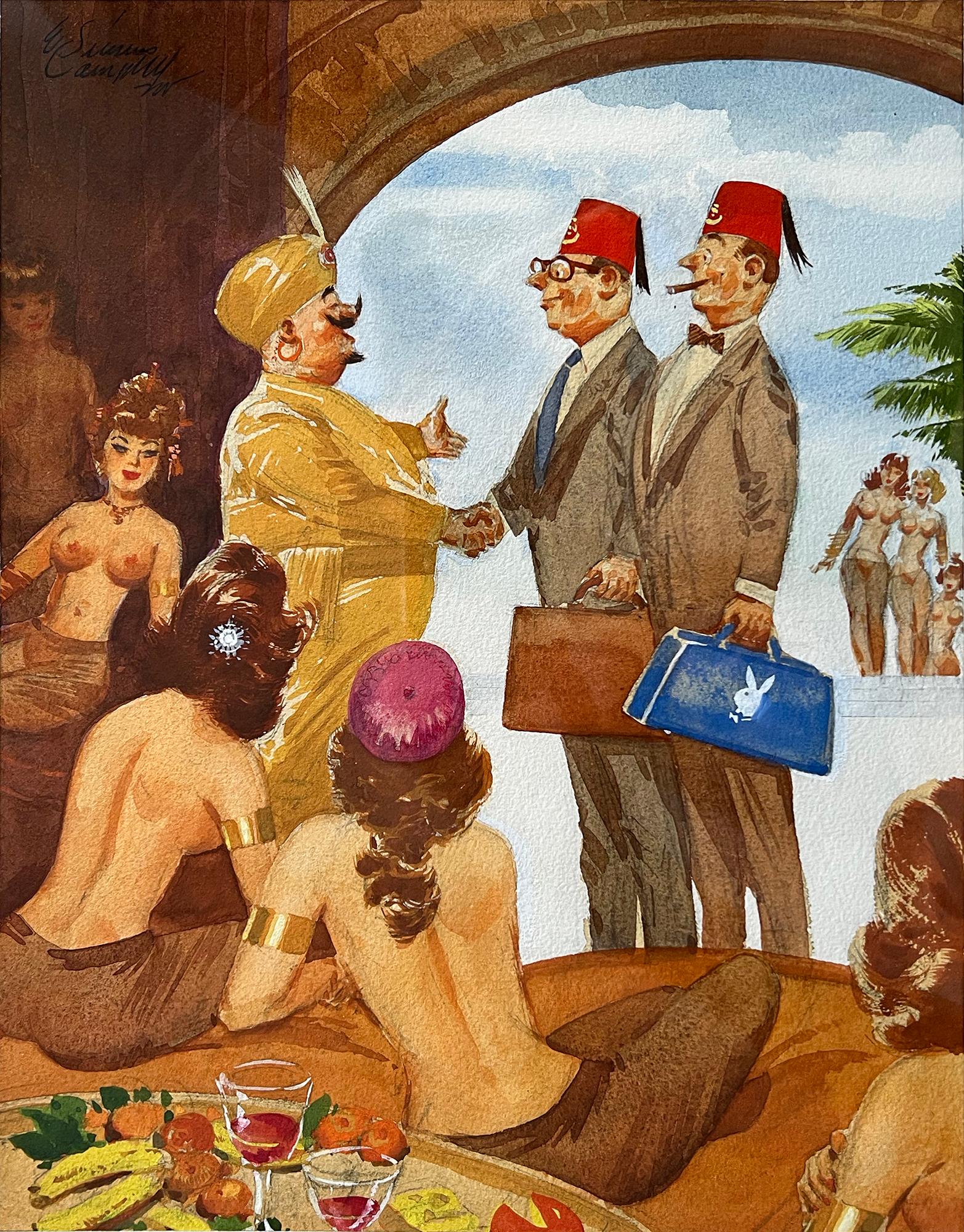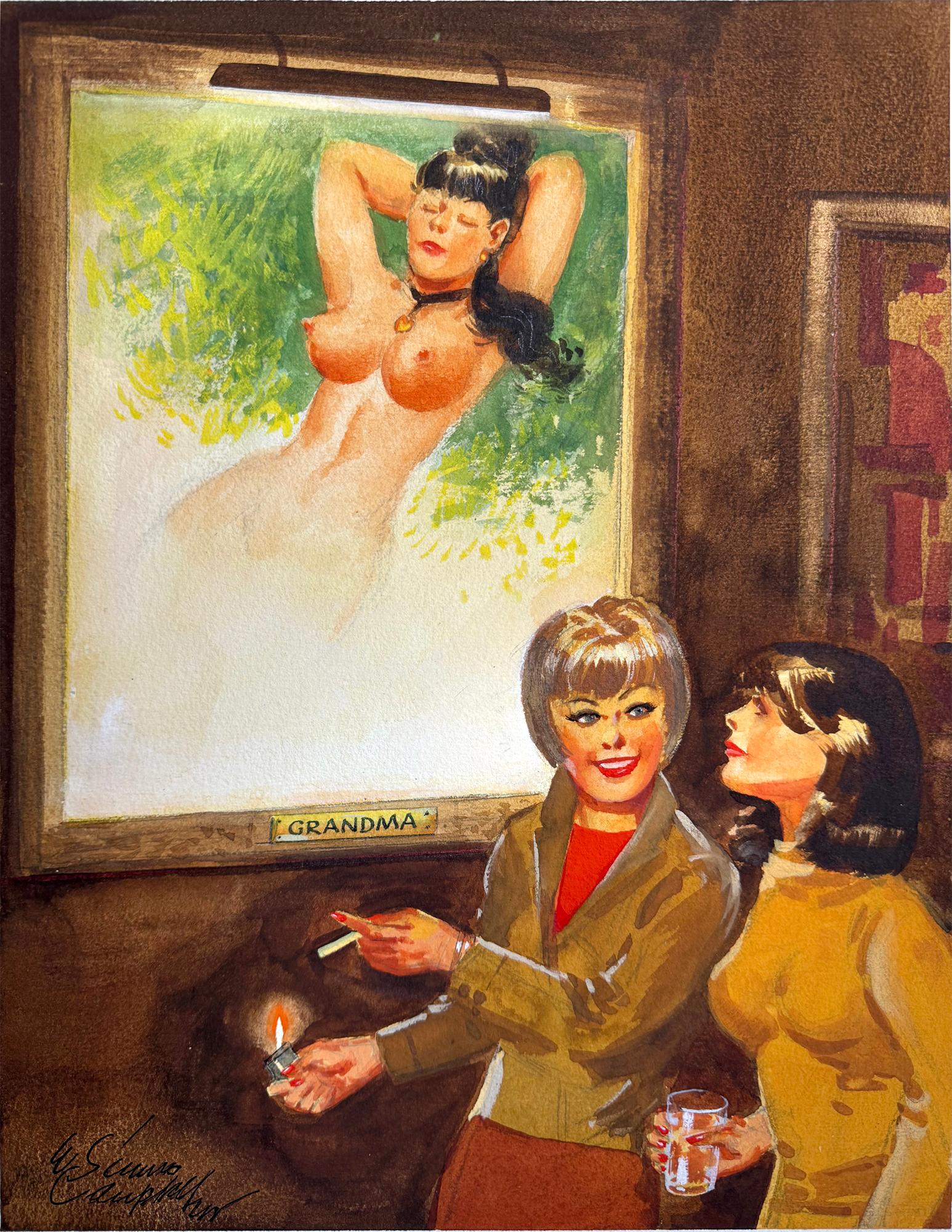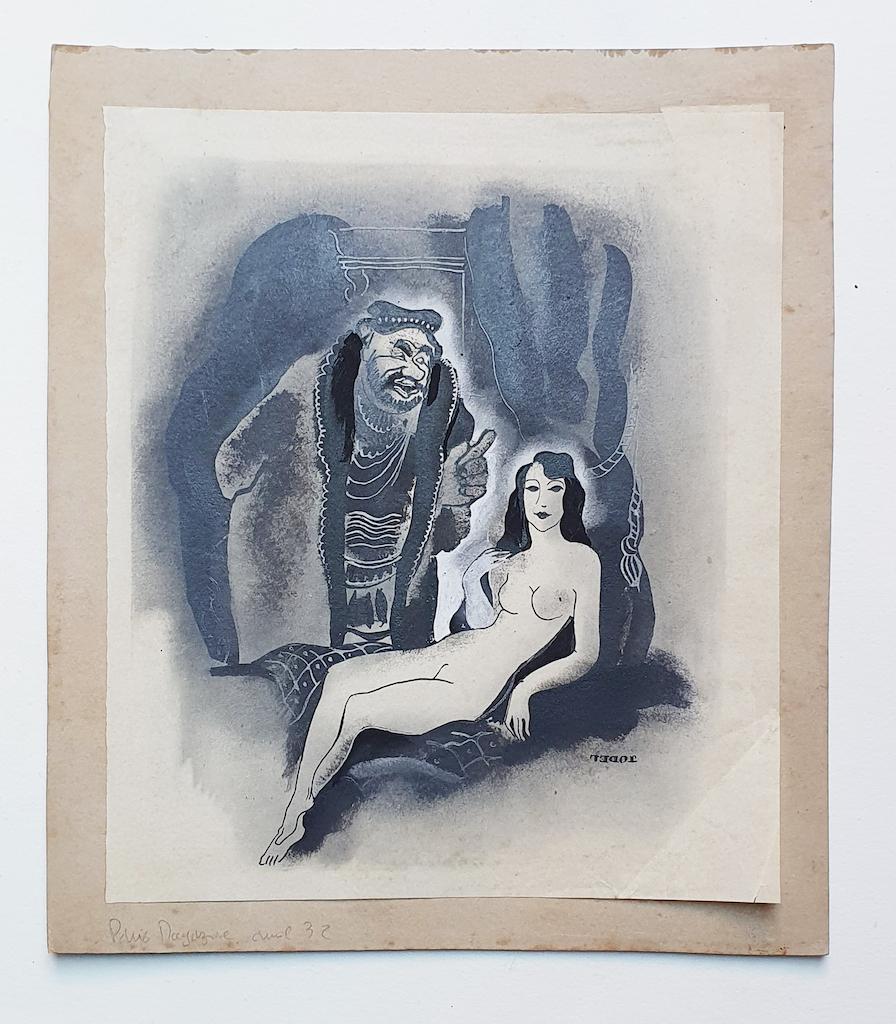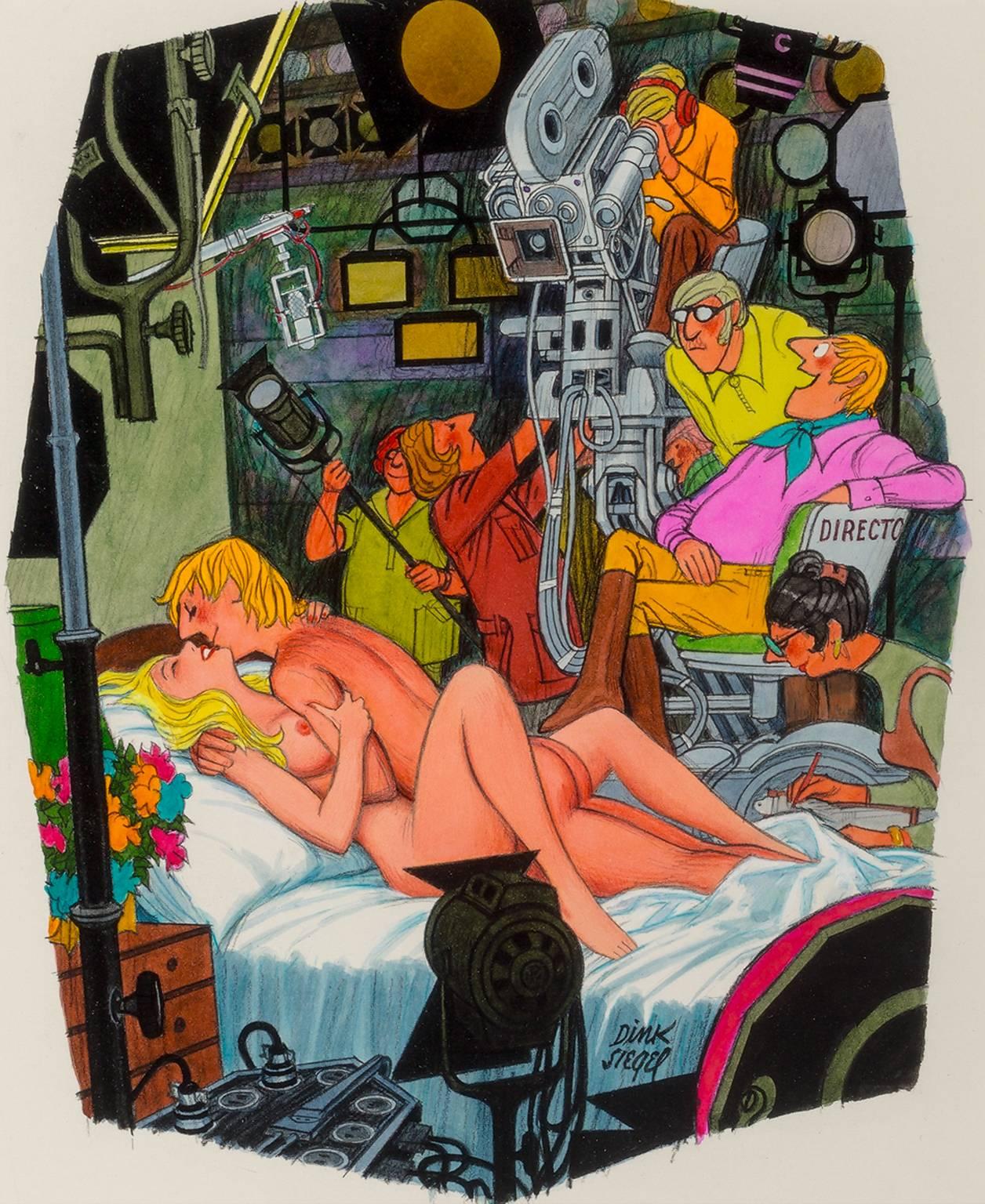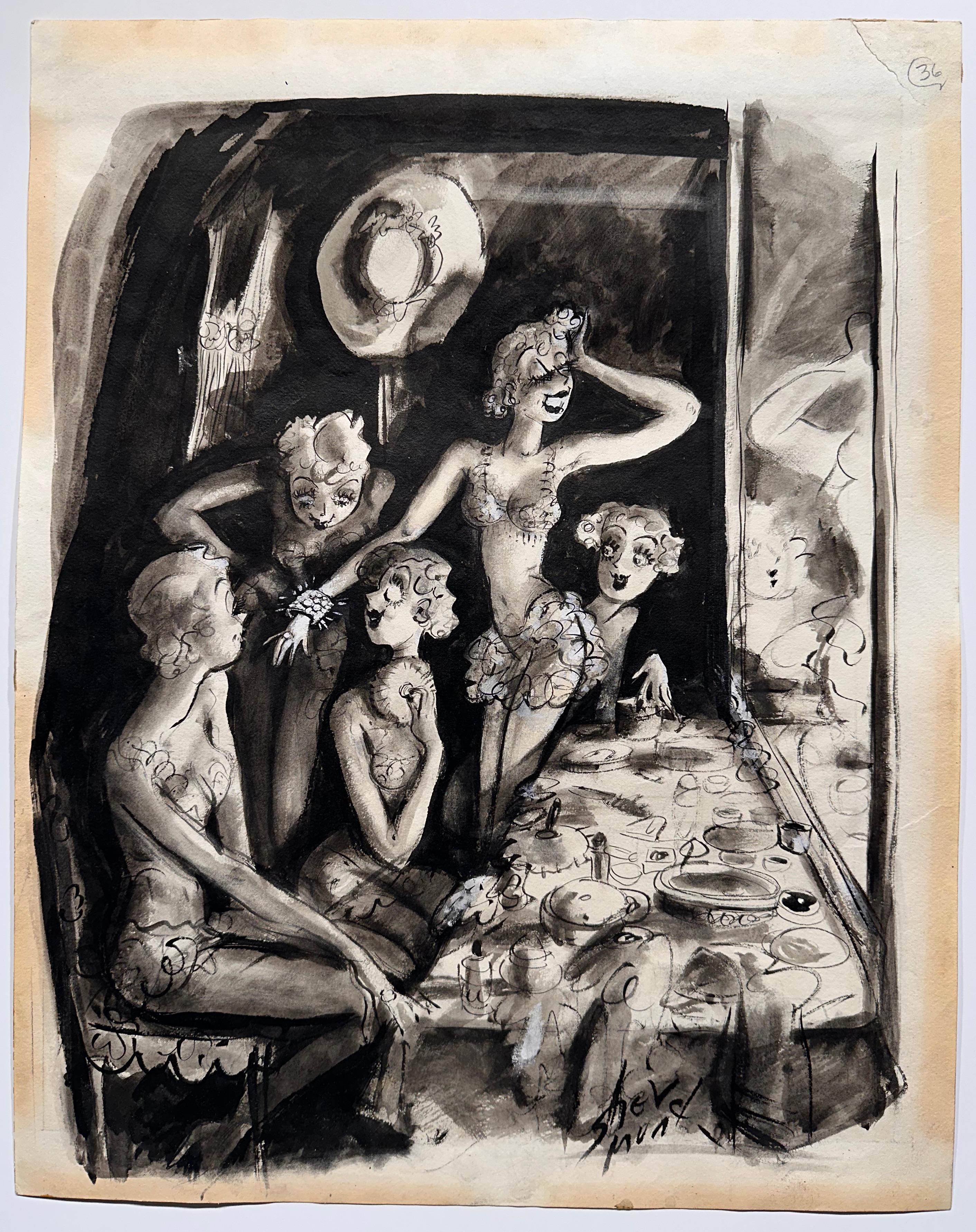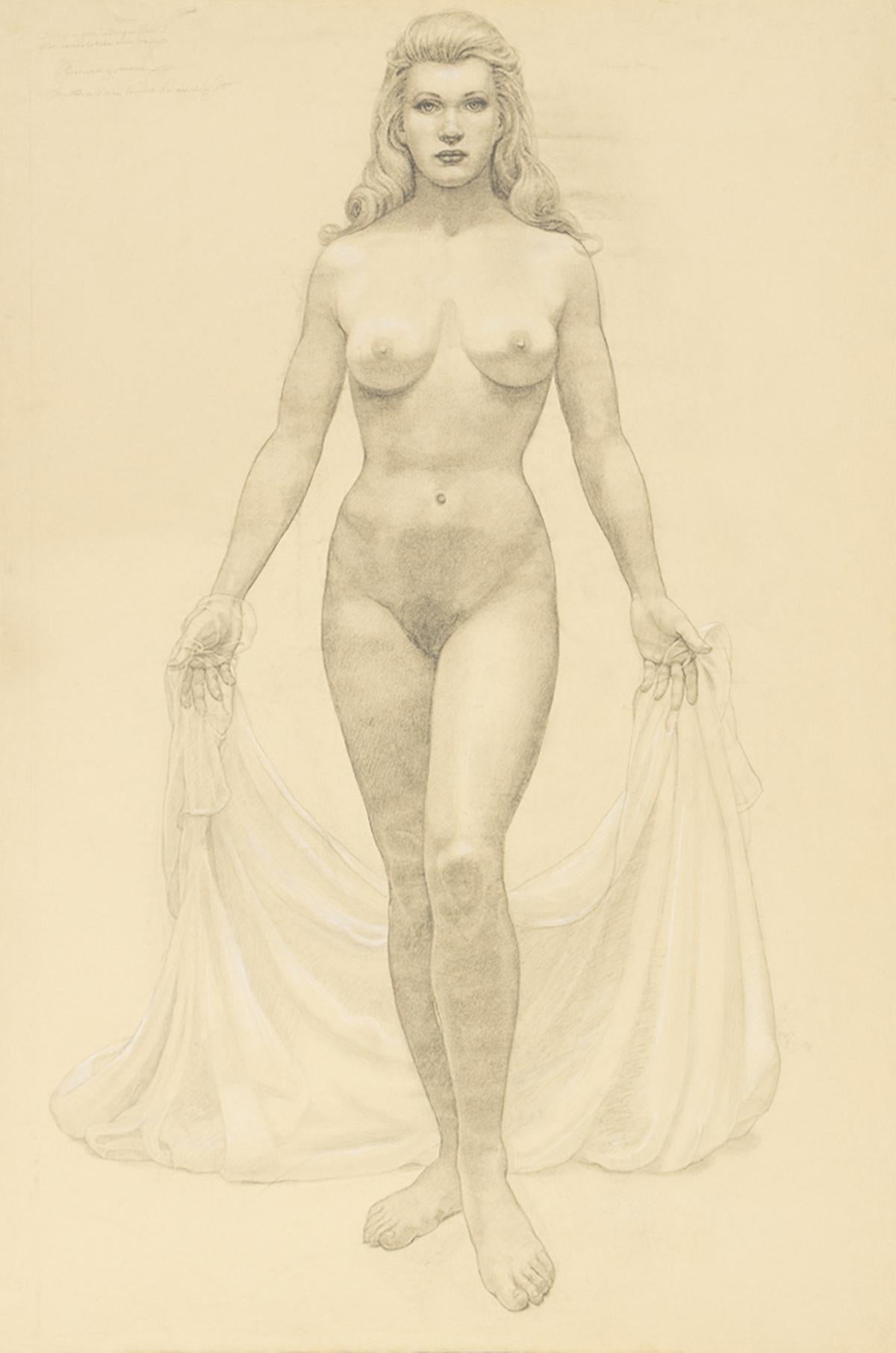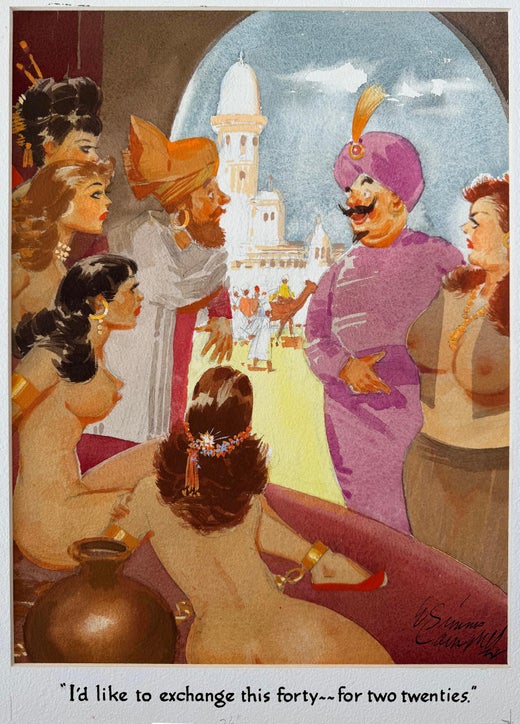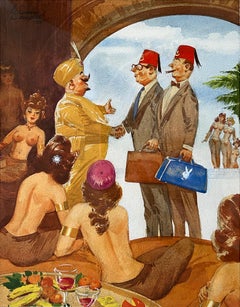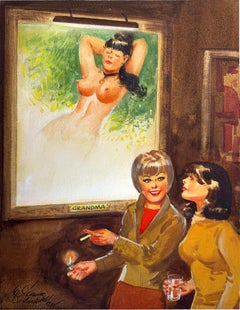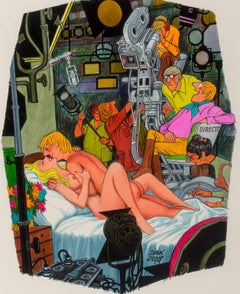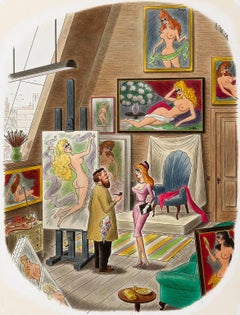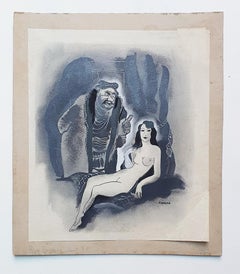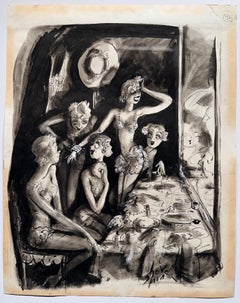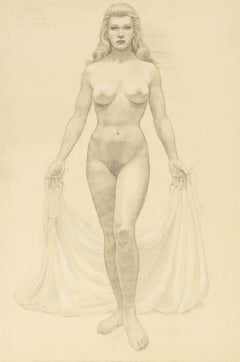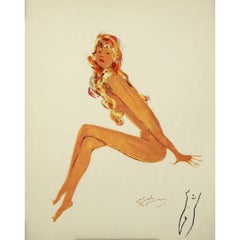Items Similar to Harem: Sexy Nude Girl Illustration for Playboy. First Black Illustrator
Video Loading
Want more images or videos?
Request additional images or videos from the seller
1 of 18
E. Simms CampbellHarem: Sexy Nude Girl Illustration for Playboy. First Black Illustrator1960
1960
$25,000
£19,231.67
€22,322.50
CA$35,255.97
A$39,492.62
CHF 20,742.95
MX$480,217.50
NOK 262,673.46
SEK 249,347.75
DKK 166,601.42
About the Item
Playboy Magazine ran this joke cartoon illustration in color on page 43 for the October 1960 edition.
Signed lower right.
The work is executed on a heavy Whatman Illustration board. The caption, " I'd like to exchange this forty-for-two twenties," is done on another illustration board and glued to the Whatman board. The Whatman board dimensions are 16 5/8 x 13. The top illustration board dimensions are 14 1/4 x 17 3/4.
The uploaded video on 1stDibs is coming up a bit off color. Refer to the still images for more accurate color.
E. Simms Campbel was the first major African American Illustrator. He did covers for Esquire Magazine starting in the 1930s. He is a historically important but overlooked American Artist.
He created the famous bulging-eyed Esquire Mascot “Esky.”
He also worked for The Chicagoan, Cosmopolitan, Ebony, The New Yorker, Playboy, Opportunity: A Journal of Negro Life, Pictorial Review, and Redbook.
This work, "What do you mean your wife doesn't understand you ---- I'm your wife!" is from Cuties Daily Comic Strip, June 18, 1950
He was inducted into the Society of Illustrators' Hall of Fame in 2002.
- Creator:E. Simms Campbell (1906 - 1971, American)
- Creation Year:1960
- Dimensions:Height: 13.5 in (34.29 cm)Width: 10.38 in (26.37 cm)
- Medium:
- Movement & Style:
- Period:
- Condition:Very good. Colors bright and saturated.
- Gallery Location:Miami, FL
- Reference Number:1stDibs: LU385315442932
E. Simms Campbell
Elmer Simms Campbell (January 2, 1906 – January 27, 1971) was an American commercial artist best known as the cartoonist who signed his work, E. Simms Campbell. The first African-American cartoonist published in nationally distributed, slick magazines, he created Esky,the familiar pop-eyed mascot of Esquire. Campbell was born in St. Louis, Missouri, the son of educators, Elizabeth Simms Campbell & Elmer Campbell
He then enrolled in the University of Chicago. After one year, Campbell left the University of Chicago and transferred to and received his degree from the Chicago Art Institute.
He spent two years at Triad Studios before moving to New York City in 1929. taking classes at the National Academy of Design. During this time, he contributed to various magazines, notably Life, & Judge.
Following the suggestion of cartoonist Russell Patterson to focus on good girl art, Campbell created his "Harem Girls", a series of watercolor cartoons that attracted attention in the first issue of Esquire, debuting in 1933. Campbell's artwork was in almost every issue of Esquire from 1933 to 1958 & he was the creator of its continuing mascot, the cartoon character in a silk top hat.
He also contributed to The Chicagoan, Cosmopolitan, Ebony, The New Yorker, Playboy, Opportunity: A Journal of Negro Life, Pictorial Review, and Redbook.
His commercial artwork for advertising included illustrations for Barbasol, Springmaid,Hart Schaffner & Marx.
Campbell also was the author of a chapter on blues music in the 1939 book Jazzmen, a seminal study of jazz's history and development.
Campbell died in White Plains, New York, in 1971
His gag panel, Cuties, was syndicated by King Features in more than 145 newspapers "A Night-Club Map of 1930s Harlem"
Of enduring cultural & historical interest is the witty, cartoon-filled map Campbell drew in 1932 – "A Night-Club Map of 1930s Harlem" identifying the attractions of Harlem during the Harlem Renaissance and adding his personal notes. He captures the intensity of the scene: within a few blocks of each other he has cartooned Cab Calloway singing at the Cotton Club, Bill "Bojangles" Robinson doing his step dance at the Lafayette Theater – "Friday night is the Midnight show, Most Negro revues begin and end here." Lissome "cafe au lait girls" dance at Small's Paradise. Outside, doormen welcome White swells in top hats, while an elegant Black couple in evening dress dance "the Bump"
Campbell's map appears in the book version of Ken Burns's documentary Jazz. The map in its entirety also appears as the inside front cover of "Of Minnie the Moocher and Me", the autobiography of Cab Calloway by Cab Calloway and Bryant Rollins (TY Crowell, 1976). Jazz historian Mike Thibault reports that the original was displayed by the Smithsonian in 1996.The map is currently held at the Yale Beinecke Rare Book & Manuscript Library.
On April 4, 2017, National Geographic published an article on the map that included the map and several enlarged sections of it. They featured it again during 2020 to subscribers of their newsletter, among a collection of unique maps of New York City.
Recognition
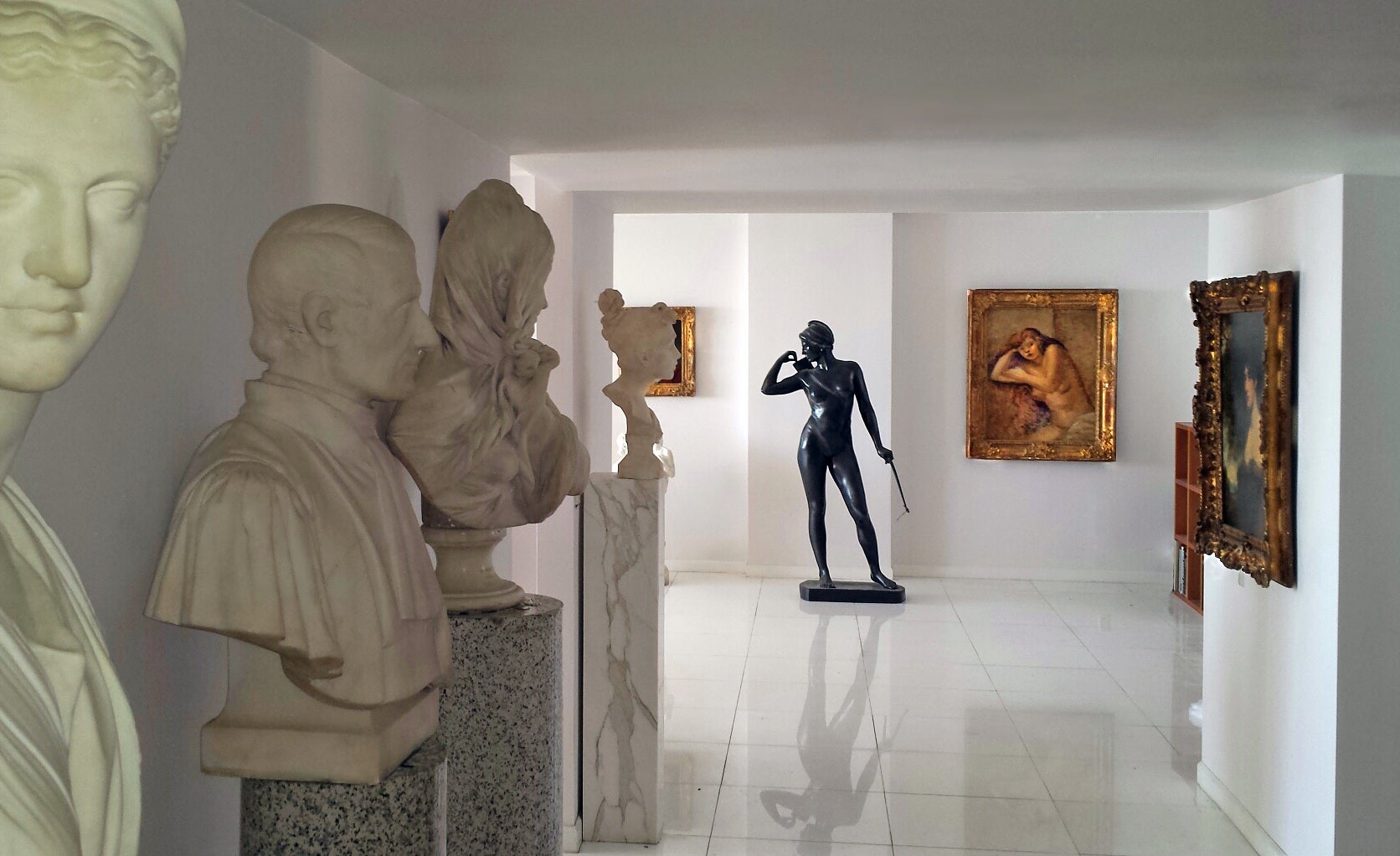
About the Seller
4.9
Gold Seller
Premium sellers maintaining a 4.3+ rating and 24-hour response times
Established in 2005
1stDibs seller since 2016
115 sales on 1stDibs
Typical response time: 1 hour
- ShippingRetrieving quote...Shipping from: Miami, FL
- Return Policy
Authenticity Guarantee
In the unlikely event there’s an issue with an item’s authenticity, contact us within 1 year for a full refund. DetailsMoney-Back Guarantee
If your item is not as described, is damaged in transit, or does not arrive, contact us within 7 days for a full refund. Details24-Hour Cancellation
You have a 24-hour grace period in which to reconsider your purchase, with no questions asked.Vetted Professional Sellers
Our world-class sellers must adhere to strict standards for service and quality, maintaining the integrity of our listings.Price-Match Guarantee
If you find that a seller listed the same item for a lower price elsewhere, we’ll match it.Trusted Global Delivery
Our best-in-class carrier network provides specialized shipping options worldwide, including custom delivery.More From This Seller
View AllBeautiful Maidens Nude Women Harem, Playboy Cartoon African American Illustrator
By E. Simms Campbell
Located in Miami, FL
E. Simms Campbel was the first major African American Illustrator. He did covers for Esquire Magazine starting in the 1930s.
He created the famous bulging-eyed Esquire Mascot “Esky.”
He also worked for The Chicagoan, Cosmopolitan, Ebony, The New Yorker, Playboy, Opportunity: A Journal of Negro Life, Pictorial Review, and Redbook.
This work, "What do you mean your wife doesn't understand you ---- I'm your wife!" is from Cuties Daily Comic Strip, June 18, 1950
He was inducted into the Society of Illustrators' Hall of Fame in 2002.
His work demonstrates a deep and masterfully understanding of drawing figures and faces in an academic but stylized style.
"My pleasure, boys. Always glad to see a delegation from the States." From the Playboy Collection...
Category
1960s Impressionist Nude Paintings
Materials
Watercolor, Pencil
Nude Playboy Cartoon, First African American Illustrator Elmer Simms Campbell
By E. Simms Campbell
Located in Miami, FL
E. Simms Campbell was the first and top black commercial artist in the USA for decades.
In "Grandma," we see a deeply conceptual work, with the blank canvas as the main point of the...
Category
1960s Impressionist Nude Paintings
Materials
Watercolor, Illustration Board, Pencil
That's a Wrap, Playboy cartoon Illustration ,
By Dink Siegel
Located in Miami, FL
Dink Siegel (American, 1910-2003)
That's a Wrap, Playboy cartoon, August 1973
Mixed media on board
11.25 x 8.5 in.
Signed lower right
Category
1970s American Modern Figurative Drawings and Watercolors
Materials
Mixed Media
Playboy cartoon Illustration, "For Posing, My Terms Are a Dollar an Hour, Room
By Richard Taylor
Located in Miami, FL
Put aside Richard Taylor's dry wit. Look at his masterfully rendered figures and brilliantly constructed compositions based on a two-point perspective. Clearly, he is an underrated and overlooked talent in the class of Charles Addams. Above all, Taylor, with his heavely-lidded-eyed figure, has a style of his own. An artist who has an instantly recognized style - unique to him/her is a rarity in today's artworld of derivative artists.
"For Posing, My Terms Are a Dollar an Hour, Room, and Board", Playboy cartoon illustration...
Category
1960s Contemporary Figurative Paintings
Materials
Watercolor
Pondering being Naked - Sexy Girl taking off Bikini - Female Cartoonist
Located in Miami, FL
This work clearly has homosexual overtones which in the mid-'40s was as daring as showing nudity. I am not sure if this was the artist's intention but the salesgirl and the model look identical and she signs it twice Shermond. Added to this is a strobe light effect where the model's image is partly replicated giving the impression of 2 figures. She's lost in thought pondering the notion of removing the bows and seeing the consequences. Meanwhile, the sales girls ( perhaps her alta ego - perhaps an admirer ) eggs her on.
Caption: "You can always remove the bows if you think they're too fussy." Cover cartoon for unknown publication - Signed "Shermund" twice in the lower right image, dated on verso, and captioned in graphite in the lower margin. Original Matte and not framed - Barbara Shermund...
Category
1940s Feminist Figurative Drawings and Watercolors
Materials
Ink, Watercolor, Graphite, Paper
Sexy Evening in Bed Phone Call - Playboy Cartoon Humor - Francis Wilford Smith
Located in Miami, FL
Cartoon art is the original Conceptual Art.
Renowned British Illustrator Smilby (Francis Wilford Smith) conceptualizes a Playboy cartoon so good that no caption is needed. The exist...
Category
1970s American Modern Figurative Drawings and Watercolors
Materials
Ink, Watercolor, Illustration Board
You May Also Like
Nude - Drawing in Mixed Media on Paper - 1932
Located in Roma, IT
Nude is a drawing in mixed media on paper applied on cardboard realized by an unknown artist in 1932. With a description on the rear.
Sheet dimension: 25 x 22 cm.
Very good conditi...
Category
1930s Modern Figurative Drawings and Watercolors
Materials
Mixed Media, Ink, Watercolor
Life Magazine Art Deco Showgirls Cartoon
Located in Wilton Manors, FL
Barbara Shermund (1899-1978). Showgirls Cartoon for Life Magazine, 1934. Ink, watercolor and gouache on heavy illustration paper, matting window measures 16.5 x 13 inches; sheet measures 19 x 15 inches; Matting panel measures 20 x 23 inches. Signed lower right. Very good condition with discoloration and toning in margins. Unframed.
Provenance: Ethel Maud Mott Herman, artist (1883-1984), West Orange NJ.
For two decades, she drew almost 600 cartoons for The New Yorker with female characters that commented on life with wit, intelligence and irony.
In the mid-1920s, Harold Ross, the founder of a new magazine called The New Yorker, was looking for cartoonists who could create sardonic, highbrow illustrations accompanied by witty captions that would function as social critiques.
He found that talent in Barbara Shermund.
For about two decades, until the 1940s, Shermund helped Ross and his first art editor, Rea Irvin, realize their vision by contributing almost 600 cartoons and sassy captions with a fresh, feminist voice.
Her cartoons commented on life with wit, intelligence and irony, using female characters who critiqued the patriarchy and celebrated speakeasies, cafes, spunky women and leisure. They spoke directly to flapper women of the era who defied convention with a new sense of political, social and economic independence.
“Shermund’s women spoke their minds about sex, marriage and society; smoked cigarettes and drank; and poked fun at everything in an era when it was not common to see young women doing so,” Caitlin A. McGurk wrote in 2020 for the Art Students League.
In one Shermund cartoon, published in The New Yorker in 1928, two forlorn women sit and chat on couches. “Yeah,” one says, “I guess the best thing to do is to just get married and forget about love.”
“While for many, the idea of a New Yorker cartoon conjures a highbrow, dry non sequitur — often more alienating than familiar — Shermund’s cartoons are the antithesis,” wrote McGurk, who is an associate curator and assistant professor at Ohio State University’s Billy Ireland Cartoon Library & Museum. “They are about human nature, relationships, youth and age.” (McGurk is writing a book about Shermund.
And yet by the 1940s and ’50s, as America’s postwar focus shifted to domestic life, Shermund’s feminist voice and cool critique of society fell out of vogue. Her last cartoon appeared in The New Yorker in 1944, and much of her life and career after that remains unclear. No major newspaper wrote about her death in 1978 — The New York Times was on strike then, along with The Daily News and The New York Post — and her ashes sat in a New Jersey funeral home...
Category
1930s Art Deco Figurative Paintings
Materials
Ink, Gouache
$3,250 Sale Price
35% Off
Untitled (Female Nude)
Located in New York, NY
This drawing by James Childs is offered by CLAMP in New York City.
Category
20th Century Contemporary Drawings and Watercolor Paintings
Materials
Paper, Graphite, Charcoal
1956 lithography by Jean-Gabriel Domergue - Sylvie la manucure
By Jean-Gabriel Domergue
Located in PARIS, FR
The 1956 lithography by Jean-Gabriel Domergue Sylvie la manucure, part of the renowned La Parisienne portfolio, stands as an elegant representation of post-war French art and a celeb...
Category
1950s Prints and Multiples
Materials
Lithograph, Paper
Nude of Woman - Drawing - Mid-20th Century
Located in Roma, IT
Nude of Woman is a contemporary artwork realized by an italian artist in the mid-20th Century.
Mixed colored watercolor.
Signature and dedication on the lower left margin.
Include...
Category
Mid-20th Century Modern Figurative Drawings and Watercolors
Materials
Watercolor, Paper
The Harem - Heliogravure - 1906
Located in Roma, IT
Image dimensions: 17.7 x 13.5 cm.
The Harem is a black and white héliogravure on paper, realized in 1906 by an anonymous Austrian artist.
An original illu...
Category
Early 1900s Symbolist Figurative Prints
Materials
Engraving
